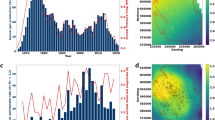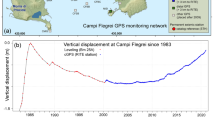Abstract
Depletion of gas fields, even in a tectonically inactive area can induce earthquakes. This is the case for the Groningen gas field, located in the north of the Netherlands. Increased seismic activity raised public concern which led to the government trying to understand the cause of the earthquakes and optimize production such as to minimize the risk of induced seismicity. The main question is how production is correlated with induced seismicity. In this paper we deal with the statistics of seismic events using Bayesian model comparison and a Bayesian change point model. We have developed a method to assess seismic event rate, its changes and tendencies. These statistical analyses are in agreement with each other and find a constant event rate up to 2003, an increasing event rate from 2003 to 2014 and a preference for a decreasing event rate from early 2014 to now. Seasonality in the production and the number of events is present. The seasonality indicates a delay ranging between 2 and 8 months between seismicity and production changes. The question of interest is whether the production reduction since January 2014 has had an effect on the seismicity occurring in the Groningen field. The number of events in the Groningen field in the area affected by the production change has been reduced significantly. We present evidence that changes in seismicity are closely related to changes in production.











Similar content being viewed by others
References
Bak P, Tang C (1989) Earthquakes as a self-organized critical phenomenon. J Geophys Res 94(B11):15635–15637
Dost B, Goutbeek F, van Eck T, Kraaijpoel D (2012) Monitoring induced seismicity in the North of the Netherlands: status report 2010. KNMI Scientific report; WR 2012-03
Gregory PC (2010) Bayesian logical data analysis for the physical sciences. Cambridge University Press, Cambridge
Gupta A, Baker JW (2015) A Bayesian change point model to detect changes in event occurrence rates, with application to induced seismicity. 12th international conference in applications of Statistics and probability in civil engineering, ICASP12
Hagoort J (1988) Fundamentals of gas reservoir engineering. Elsevier, Amsterdam
Jaynes ET (2003) Probability theory—the logic of science. Cambridge University Press, Cambridge
Jeffreys H (1961) The theory of probability. Oxford University Press, Oxford
Madsen HO, Krenk S, Lind NC (2006) Methods of structural safety. Dover, Kent
Main IG, O’Brien G, Henderson JR (2000) Statistical physics of earthquakes: comparison of distribution exponents for source area and potential energy and the dynamic emergence of log-periodic energy quanta. J Geophys Res 105(B3):6105–6126
NAM (2013) Wijziging winningsplan Groningen 2013, inclusief technische bijlage Groningen winningsplan 2013. Versie 29 November 2013. http://www.namplatform.nl/content/files/2013-11-29-gewijzigd-winningsplan-groningen-2013-openbaar-deel_zonder-contactgegevens.pdf. Accessed 10 Dec 2015
Press WH, Teukolsky SA, Vetterling WT, Flannery BP (1992) Numerical recipes. Cambridge University Press, Cambridge
Pruiksma JP, Breunese JN, van Thienen-Visser K, de Waal JA (2015) Isotach formulation of the rate type compaction model for sandstone. Int J Rock Mech Min Sci 78:127–132
Raftery A, Akman V (1986) Bayesian analysis of a poisson process with a change point. Biometrika 73(1):85–89
Reasenberg P (1985) Second-order moment of central California seismicity, 1969–82. J Geophys Res 90:5479–5495
Rudin W (1976) Principles of mathematical analysis. McGraw-Hill Kogakusha, Tokyo
SodM (2013) Reassessment of the probability of higher magnitude earthquakes in the Groningen gas field, including a position statement by KNMI. State Supervision of Mines (SodM) report dd. 16 Jan 2013. https://www.rijksoverheid.nl/binaries/rijksoverheid/documenten/rapporten/2013/01/16/reassessment-of-the-probability-of-higher-magnitude-earthquakes-in-the-groningen-gas-field/reassessment-of-the-probability-of-higher-magnitude-earthquakes-in-the-groningen-gas-field.pdf. Accessed 23 Sept 2016
TNO (2013) Toetsing van de bodemdalingsprognoses en seismische hazard ten gevolge van gaswinning van het Groningen veld. TNO report 2013 R11953, 23 December 2013. http://nlog.nl/resources/Aardbevingen%20Groningen/TNO_rapport_Groningen_15-01-2014_gelakt_pre-scan.pdf. Accessed 10 Dec 2015
TNO (2014) Recent developments of the Groningen field in 2014 and, specifically, the southwest periphery of the field. TNO report 2014 R 11703, 9 December 2014. http://nlog.nl/resources/Aardbevingen%20Groningen/final%20TNO%20report%20EKL.pdf. Accessed 10 Dec 2015
TNO (2015a) Recent developments on the seismicity of the Groningen field in 2015. TNO report 2015 R10755, 29 May 2015. http://nlog.nl/resources/Aardbevingen%20Groningen/Recent%20developments%20on%20the%20seismicity%20of%20the%20Groningen%20field%20in%202015_TNO_2015_R10755.pdf. Accessed 17 Dec 2015
TNO (2015b) Response of induced seismicity to production changes in the Groningen field. TNO report 2015 R11367, 10 November 2015. http://nlog.nl/resources/Aardbevingen%20Groningen/TNO%202015%20R11367_FINAL_TNO_report_nov%202015.pdf. Accessed 18 Dec 2015
Touati S, Naylor M, Main I (2016) Detection of change points in underlying earthquake rates, with application to global mega-earthquakes. Geophys J Int 204:753–767. doi:10.1093/gji/ggv398
van Wees JD, Buijze L, van Thienen-Visser K, Nepveu M, Wassing BBT, Orlic B (2014) Geomechanics response and induced seismicity during gas field depletion in the Netherlands. Geothermics 52:206–219
Acknowledgments
We like to thank Annemarie Muntendam-Bos, Hans Roest and Hans de Waal from “Staatstoezicht op de Mijnen” and Frank Pijpers from “Centraal Bureau voor Statistiek” and Jaap Breunese from TNO for regular stimulating discussions on the topic of this paper and related issues.
Author information
Authors and Affiliations
Corresponding author
Appendix: Normalization of cross correlations
Appendix: Normalization of cross correlations
The cross-correlation of two functions f and g on the real t-axis is defined as the Riemann–Stieltjes integral
Either we choose α = t or take a step function for α. In this way we incorporate (Riemann) integrals and series into one formalism (Rudin 1976, Chapter 6). We leave the integration boundaries unspecified as yet.
Now form \({\text{Q}} \equiv \int {\left[ {{\text{f}}\left( {\text{t}} \right) - \lambda {\text{g}}\left( {{\text{t}} + {\text{k}}} \right)} \right]^{2} {\text{d}}\alpha \left( {\text{t}} \right)}\), λ being a real number. Then Q is obviously non-negative.
Hence \(\lambda^{2} \int {{\text{g}}\left( {{\text{t}} + {\text{k}}} \right)^{2} {\text{d}}\alpha \left( {\text{t}} \right)} - 2\lambda \int {} {\text{f}}\left( {\text{t}} \right){\text{g}}\left( {{\text{t}} + {\text{k}}} \right){\text{d}}\alpha \left( {\text{t}} \right) + \int {{\text{f}}\left( {\text{t}} \right)^{2} {\text{d}}\alpha \left( {\text{t}} \right) \ge 0}\).
In order that this quadratic equation in λ satisfies this inequality for all functions f and g the discriminant should be non-positive. This leads to the general requirement that
If we now set the integration boundaries to −∞ and +∞ we retrieve the familiar Cauchy–Schwarz inequality, since k can then be omitted from the last integral for the given choices of α. We can now normalize the cross-correlation with the square root of the auto-correlations of f and g taken at lag 0, with the neat result that the cross-correlation so normalized is confined to [− 1, 1].
However, we are obviously dealing with data over a finite time interval. We normalized the cross-correlation function with the square root of the right hand side, taking k = 0, since lag-dependent normalization gives obviously rise to distortion, which is unacceptable. But then we have no guarantee that the cross-correlation so normalized always remains between −1 and 1.
Rights and permissions
About this article
Cite this article
Nepveu, M., van Thienen-Visser, K. & Sijacic, D. Statistics of seismic events at the Groningen field. Bull Earthquake Eng 14, 3343–3362 (2016). https://doi.org/10.1007/s10518-016-0007-4
Received:
Accepted:
Published:
Issue Date:
DOI: https://doi.org/10.1007/s10518-016-0007-4




